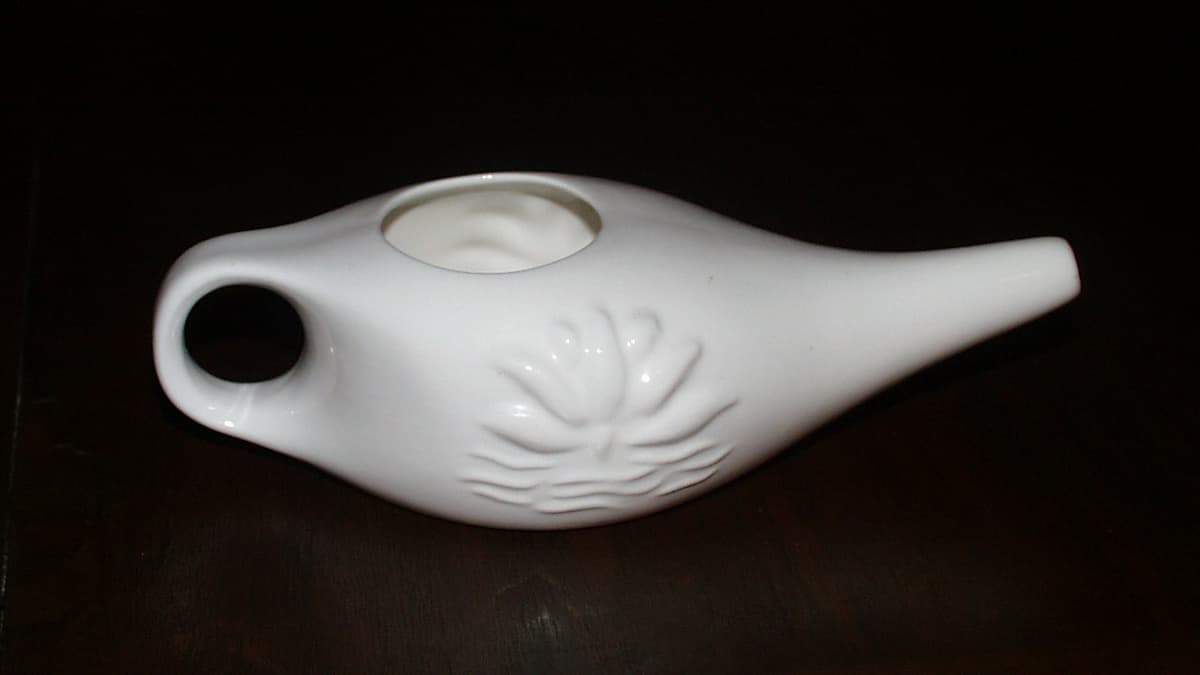Overview
Neti in Yoga is the process of cleansing the nasal passage. It is one of the Shatkriya, the six yogic cleansing processes. To perform this Kriya correctly, you must have a Neti Pot, a pot specially made for this purpose. Also, you must know how to use a Neti Pot.
Medieval Yoga texts like Hatha Yoga Pradipika, Gheranda Samhita, Hatha Ratnavali, and Hatha Tattva Kaumudi describe this cleaning practice in detail.
In this article, we discuss its meaning, types, steps, precautions, dangers, and benefits. Moreover, this article helps to learn how to use a Neti Pot.
Neti in Yoga Meaning
In the Pali language, Neti means the one that leads, guides, or caries away. In Sanskrit dictionaries (Monier Williams and Cologne Digital Sanskrit Dictionaries), we could find the meaning of Neti as the drawing of a thread through the nose and mouse(as a kind of penance). Besides this, there is another meaning in Sanskrit namely ‘Not this or ‘Not so’ (Na iti). But this meaning is not relevant to our context and hence we may ignore it. A large part of Pali and Sanskrit word-stems are identical and therefore, we may take the meaning of Neti as carries away in Pali for our purpose. Neti is the process that carries away the impurities.
Types of Neti In Yoga
There are two types of Neti in Yoga namely Sutra Neti and Jala Neti.
Sutra Neti
Sutra in Sanskrit means a thread. Hence, it is the process of cleansing the nasal passage with the help of a thread. Medieval yoga texts predominantly describe only Sutra Neti.
A six inches long string of threads should be passed through the nasal passage and the end be taken out in the mouth. Adepts call it Neti Karma.
Hatha Yoga Pradipika 1.29
A cotton thread was prepared and dipped in melted beeswax before being inserted into the nasal passage in traditional yoga practices. Presently, yogis use a rubber catheter or thin cotton thread lubricated with butter. You can easily buy a suitable thread or rubber catheter online for this purpose.
Steps to Perform Sutra Neti
- Assume a standing position or a sitting position with the trunk erect.
- Then, lubricate the catheter or the thread with one end and insert it into the nasal passage. Twisting the thread will make it glide smoothly into the passage.
- When the thread reaches the top of the throat, open the mouth and get hold of the thread.
- After holding both ends of the thread with your hands, move it forward and backward gently ten to twenty times.
- Then, pull out the thread from the nose and repeat the same process with the opposite nostril.
Benefits of Sutra Neti
- It removes mucus in the passage and ensures the free flow of air. Hence, it is helpful for the practice of Pranayama.
- Besides, it relieves allergies and is helpful in the management of respiratory diseases like Asthma.
- It helps to activate Ajna Chakra.
- It maintains the flow of air through both nostrils freely which helps both sides of the brain to function more efficiently. Thus, it improves the overall health of the individual.
- A study (K.K. Ramalingam and M.C.F. Smith) indicates that Sutra Neti is beneficial to obstructive sleep apnea and snoring.
By Practicing Neti Kriya, the Yogi obtains Khechari Siddhi. Also, it destroys the phlegm and gives clairvoyance or clear sight.
Gheranda Samhita 1.51
Sutra Neti Precautions
The inner lining of the nose is very smooth. It is possible that the practice, if not done correctly, can damage the inner lining. To avoid this danger of Sutra Neti, learn this kriya from a Yoga Teacher.
Also, people tending to nasal bleeding should avoid this practice.
One should ensure the thread or catheter is sterile and clean.
One should avoid the vigorous practice of this Kriya which may lead to velopharyngeal stenosis requiring surgical intervention. (H. Tiwana et al)
Jala Neti
Jala in Sanskrit means water. Therefore it is the process of cleansing the nasal passage with water. One should practice Jala Neti after Sutra Neti for better results. A Neti Pot is required for its performance.
How to use a Neti Pot
- Take a sufficient amount of water and mix it with two teaspoons of salt per liter of water.
- Then, fill the Neti Pot with water prepared.
- Stand with legs apart and lean forward. Tilt the head towards one side so that one little above the other. It will make water flow from one nostril to another.
- Insert the nozzle of the pot into the upper nostril. Also, ensure that there is no leakage in the upper nostril. Then, raise the neti pot and adjust the position of the head so that the water flows into the upper nose and runs out of the other nostril. During the process, ensure breathing is through the mouth only.
- Then, remove the nozzle out of the nose and straighten your body and the head so that the rest of the water runs down freely. Now, breathe through the nose.
- Remove the mucus and the water.
- Repeat the process on the opposite side.
- To dry the nostrils, perform Kapalbhati twenty to twenty-five times.
Jala Neti in Yoga Practice Notes
Neti can be practiced daily before the practice of Asana and Pranayama. In case of cold and nasal blockage due to cold, one can practice this kriya multiple times daily. However, one should avoid this practice after a meal. After the completion of Sutra Neti, One should practice this Kriya for better results.
Precautions
Water should not enter the mouth or throat.
The proportion of salt to water should be ideal. Otherwise, it will cause irritation.
Persons having structural blockages in the nose should avoid this practice.
Benefits of Jala Neti Kriya
- It removes the mucus and pollutants from nasal passages and sinuses. Hence, it is helpful for the practice of Pranayama.
- Also, it helps to manage allergies and boost respiratory functions. Many studies support the role of Neti in treating sinusitis, and rhinosinusitis, and improving vision.
- Severe cold results in mouth breathing. This kriya helps reduce the symptoms.
- Besides, it helps to boost the functions of the brain and prevent anxiety, anger, and depression. Also, it improves the presence of mind and intelligence.
- A 5-year follow-up study suggests that long-term nasal irrigation helps improve the quality of life in patients affected with nasopharyngeal carcinoma. Another study confirms this and observes the reduced symptoms in nasopharyngeal carcinoma patients after irradiation.



